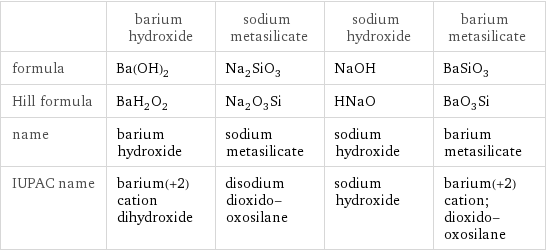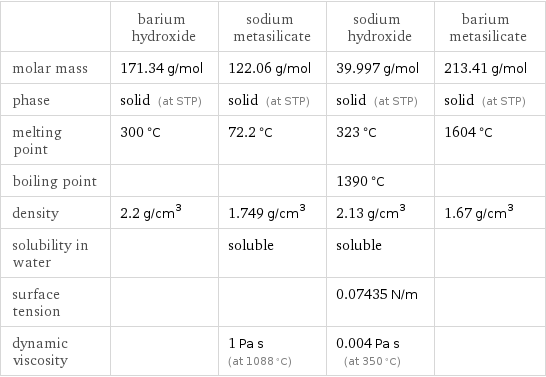Input interpretation

Ba(OH)_2 barium hydroxide + Na_2SiO_3 sodium metasilicate ⟶ NaOH sodium hydroxide + BaSiO_3 barium metasilicate
Balanced equation

Balance the chemical equation algebraically: Ba(OH)_2 + Na_2SiO_3 ⟶ NaOH + BaSiO_3 Add stoichiometric coefficients, c_i, to the reactants and products: c_1 Ba(OH)_2 + c_2 Na_2SiO_3 ⟶ c_3 NaOH + c_4 BaSiO_3 Set the number of atoms in the reactants equal to the number of atoms in the products for Ba, H, O, Na and Si: Ba: | c_1 = c_4 H: | 2 c_1 = c_3 O: | 2 c_1 + 3 c_2 = c_3 + 3 c_4 Na: | 2 c_2 = c_3 Si: | c_2 = c_4 Since the coefficients are relative quantities and underdetermined, choose a coefficient to set arbitrarily. To keep the coefficients small, the arbitrary value is ordinarily one. For instance, set c_1 = 1 and solve the system of equations for the remaining coefficients: c_1 = 1 c_2 = 1 c_3 = 2 c_4 = 1 Substitute the coefficients into the chemical reaction to obtain the balanced equation: Answer: | | Ba(OH)_2 + Na_2SiO_3 ⟶ 2 NaOH + BaSiO_3
Structures

+ ⟶ +
Names

barium hydroxide + sodium metasilicate ⟶ sodium hydroxide + barium metasilicate
Equilibrium constant
![Construct the equilibrium constant, K, expression for: Ba(OH)_2 + Na_2SiO_3 ⟶ NaOH + BaSiO_3 Plan: • Balance the chemical equation. • Determine the stoichiometric numbers. • Assemble the activity expression for each chemical species. • Use the activity expressions to build the equilibrium constant expression. Write the balanced chemical equation: Ba(OH)_2 + Na_2SiO_3 ⟶ 2 NaOH + BaSiO_3 Assign stoichiometric numbers, ν_i, using the stoichiometric coefficients, c_i, from the balanced chemical equation in the following manner: ν_i = -c_i for reactants and ν_i = c_i for products: chemical species | c_i | ν_i Ba(OH)_2 | 1 | -1 Na_2SiO_3 | 1 | -1 NaOH | 2 | 2 BaSiO_3 | 1 | 1 Assemble the activity expressions accounting for the state of matter and ν_i: chemical species | c_i | ν_i | activity expression Ba(OH)_2 | 1 | -1 | ([Ba(OH)2])^(-1) Na_2SiO_3 | 1 | -1 | ([Na2SiO3])^(-1) NaOH | 2 | 2 | ([NaOH])^2 BaSiO_3 | 1 | 1 | [BaSiO3] The equilibrium constant symbol in the concentration basis is: K_c Mulitply the activity expressions to arrive at the K_c expression: Answer: | | K_c = ([Ba(OH)2])^(-1) ([Na2SiO3])^(-1) ([NaOH])^2 [BaSiO3] = (([NaOH])^2 [BaSiO3])/([Ba(OH)2] [Na2SiO3])](../image_source/0d5bf0753620f1ffcef5b1aaa3524611.png)
Construct the equilibrium constant, K, expression for: Ba(OH)_2 + Na_2SiO_3 ⟶ NaOH + BaSiO_3 Plan: • Balance the chemical equation. • Determine the stoichiometric numbers. • Assemble the activity expression for each chemical species. • Use the activity expressions to build the equilibrium constant expression. Write the balanced chemical equation: Ba(OH)_2 + Na_2SiO_3 ⟶ 2 NaOH + BaSiO_3 Assign stoichiometric numbers, ν_i, using the stoichiometric coefficients, c_i, from the balanced chemical equation in the following manner: ν_i = -c_i for reactants and ν_i = c_i for products: chemical species | c_i | ν_i Ba(OH)_2 | 1 | -1 Na_2SiO_3 | 1 | -1 NaOH | 2 | 2 BaSiO_3 | 1 | 1 Assemble the activity expressions accounting for the state of matter and ν_i: chemical species | c_i | ν_i | activity expression Ba(OH)_2 | 1 | -1 | ([Ba(OH)2])^(-1) Na_2SiO_3 | 1 | -1 | ([Na2SiO3])^(-1) NaOH | 2 | 2 | ([NaOH])^2 BaSiO_3 | 1 | 1 | [BaSiO3] The equilibrium constant symbol in the concentration basis is: K_c Mulitply the activity expressions to arrive at the K_c expression: Answer: | | K_c = ([Ba(OH)2])^(-1) ([Na2SiO3])^(-1) ([NaOH])^2 [BaSiO3] = (([NaOH])^2 [BaSiO3])/([Ba(OH)2] [Na2SiO3])
Rate of reaction
![Construct the rate of reaction expression for: Ba(OH)_2 + Na_2SiO_3 ⟶ NaOH + BaSiO_3 Plan: • Balance the chemical equation. • Determine the stoichiometric numbers. • Assemble the rate term for each chemical species. • Write the rate of reaction expression. Write the balanced chemical equation: Ba(OH)_2 + Na_2SiO_3 ⟶ 2 NaOH + BaSiO_3 Assign stoichiometric numbers, ν_i, using the stoichiometric coefficients, c_i, from the balanced chemical equation in the following manner: ν_i = -c_i for reactants and ν_i = c_i for products: chemical species | c_i | ν_i Ba(OH)_2 | 1 | -1 Na_2SiO_3 | 1 | -1 NaOH | 2 | 2 BaSiO_3 | 1 | 1 The rate term for each chemical species, B_i, is 1/ν_i(Δ[B_i])/(Δt) where [B_i] is the amount concentration and t is time: chemical species | c_i | ν_i | rate term Ba(OH)_2 | 1 | -1 | -(Δ[Ba(OH)2])/(Δt) Na_2SiO_3 | 1 | -1 | -(Δ[Na2SiO3])/(Δt) NaOH | 2 | 2 | 1/2 (Δ[NaOH])/(Δt) BaSiO_3 | 1 | 1 | (Δ[BaSiO3])/(Δt) (for infinitesimal rate of change, replace Δ with d) Set the rate terms equal to each other to arrive at the rate expression: Answer: | | rate = -(Δ[Ba(OH)2])/(Δt) = -(Δ[Na2SiO3])/(Δt) = 1/2 (Δ[NaOH])/(Δt) = (Δ[BaSiO3])/(Δt) (assuming constant volume and no accumulation of intermediates or side products)](../image_source/212a3a9b13ca2b4f17569097f657d250.png)
Construct the rate of reaction expression for: Ba(OH)_2 + Na_2SiO_3 ⟶ NaOH + BaSiO_3 Plan: • Balance the chemical equation. • Determine the stoichiometric numbers. • Assemble the rate term for each chemical species. • Write the rate of reaction expression. Write the balanced chemical equation: Ba(OH)_2 + Na_2SiO_3 ⟶ 2 NaOH + BaSiO_3 Assign stoichiometric numbers, ν_i, using the stoichiometric coefficients, c_i, from the balanced chemical equation in the following manner: ν_i = -c_i for reactants and ν_i = c_i for products: chemical species | c_i | ν_i Ba(OH)_2 | 1 | -1 Na_2SiO_3 | 1 | -1 NaOH | 2 | 2 BaSiO_3 | 1 | 1 The rate term for each chemical species, B_i, is 1/ν_i(Δ[B_i])/(Δt) where [B_i] is the amount concentration and t is time: chemical species | c_i | ν_i | rate term Ba(OH)_2 | 1 | -1 | -(Δ[Ba(OH)2])/(Δt) Na_2SiO_3 | 1 | -1 | -(Δ[Na2SiO3])/(Δt) NaOH | 2 | 2 | 1/2 (Δ[NaOH])/(Δt) BaSiO_3 | 1 | 1 | (Δ[BaSiO3])/(Δt) (for infinitesimal rate of change, replace Δ with d) Set the rate terms equal to each other to arrive at the rate expression: Answer: | | rate = -(Δ[Ba(OH)2])/(Δt) = -(Δ[Na2SiO3])/(Δt) = 1/2 (Δ[NaOH])/(Δt) = (Δ[BaSiO3])/(Δt) (assuming constant volume and no accumulation of intermediates or side products)
Chemical names and formulas

| barium hydroxide | sodium metasilicate | sodium hydroxide | barium metasilicate formula | Ba(OH)_2 | Na_2SiO_3 | NaOH | BaSiO_3 Hill formula | BaH_2O_2 | Na_2O_3Si | HNaO | BaO_3Si name | barium hydroxide | sodium metasilicate | sodium hydroxide | barium metasilicate IUPAC name | barium(+2) cation dihydroxide | disodium dioxido-oxosilane | sodium hydroxide | barium(+2) cation; dioxido-oxosilane
Substance properties

| barium hydroxide | sodium metasilicate | sodium hydroxide | barium metasilicate molar mass | 171.34 g/mol | 122.06 g/mol | 39.997 g/mol | 213.41 g/mol phase | solid (at STP) | solid (at STP) | solid (at STP) | solid (at STP) melting point | 300 °C | 72.2 °C | 323 °C | 1604 °C boiling point | | | 1390 °C | density | 2.2 g/cm^3 | 1.749 g/cm^3 | 2.13 g/cm^3 | 1.67 g/cm^3 solubility in water | | soluble | soluble | surface tension | | | 0.07435 N/m | dynamic viscosity | | 1 Pa s (at 1088 °C) | 0.004 Pa s (at 350 °C) |
Units
